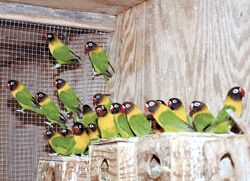
James McDonald of Kerrville, Texas says pet bird production can be extremely profitable, thanks to the low overhead required, and high returns on baby birds.
McDonald should know. He has made a good living for 25 years on less than one acre, and he knows many others who have profited from either part-time or full-time bird breeding businesses.
McDonald has raised and sold one million pet birds in his career and now encourages others to take up this enjoyable and profitable career. He has written a book that details how it can be done.
"Raising exotic birds is not difficult. It doesn't require a high-powered education -- just common sense," he says. "And there is strong demand for your young birds, thanks to more than 8,000 individual retail pet shops in the U.S. These birds have relatively short life spans, and that in itself, creates a never-ending demand for them."
McDonald says the pet industry has continued to show growth, regardless of how the rest of the economy is doing. The business of breeding birds is not a fad, but instead has a good history and a solid track record behind it.
"If you are looking for a get-rich-quick business, this isn't for you. It is, however, a little known, but proven business that has been around since the early 1900's." McDonald explains.
Also, the exotic bird business is not dominated by any large conglomerate, as are many businesses. Practically all of the birds supplied to the pet bird industry today are bred by mom and pop operations throughout the country. That's because this business can be done almost anywhere -- rural or urban.
"People have successfully raised birds in anything from a basement, to a patio, a portable building, mobile home or a custom built commercial size building," he says. "A portable building in the backyard is a very popular and inexpensive method that many people choose."
According to McDonald, it's important to be within a 4 to 5 hour drive of a major airport. That's because you'll be able to ship birds by airfreight anywhere in the U.S.
The ideal temperature range for maximum production is somewhere between 55 and 85 degrees, although they can tolerate a much wider range when not breeding.
According to McDonald, the bulk of the market is in the northern part of the U.S., since that is where the population is the heaviest.
"We ship around 90 per cent of all our birds up north," he says.
McDonald does not consider this type of business to be labor intensive and says the time commitment doesn't have to confining, even for very big operations.
McDonald recommends that people start small and grow into the business. It is the type of thing that can be started on a small scale with a very minimum start-up cost, he says. You don't need incubators or high priced equipment since the birds raise their own young.
Zebra finches, lovebirds, cockatiels, or parakeets are good birds to start with. They have the shortest natural life spans, and therefore, are in constant demand. Also, the smaller exotic birds are less noisy.
"Parakeets, cockatiels, lovebirds and finches will breed 12 months out of the year if they are provided with the right environment, which makes it an ideal project for someone who wants a monthly income rather than a once a year crop," McDonald says.
"These birds reach sexual maturity at anywhere from four to eight months of age and will produce for three to 10 years, depending on the species. They will average four to six babies per clutch and average four to six clutches per year. Weaning ages (and saleable age) range from six to 12 weeks of age," he explains.
McDonald says that most breeders take the easiest route, and sell to wholesale buyers, who then ship them to pet shops nationwide. It is also possible to sell directly to the pet shops or retail birds yourself, however.
According to McDonald, parakeets are by far the most popular of all pet birds, followed by cockatiels, lovebirds and finches.
McDonald's book is 250 pages, and has more than 90 pictures and illustrations. He says that four chapters of it are devoted to marketing, with tried and true advice. The book is called, "The Complete Guide to Raising Pet Birds for Profit -- The Greatest Backyard Business Ever."
